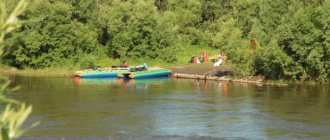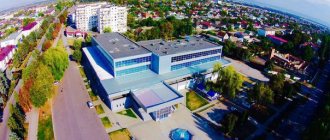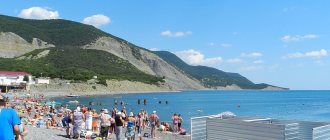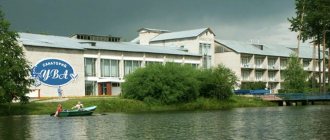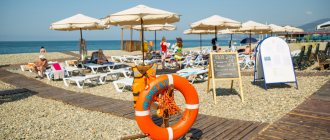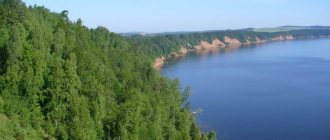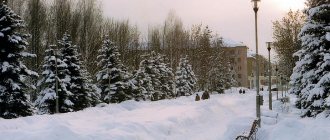Founded: 1760
City Day is celebrated
on June 12
.
Izhevsk arms factory
Izhevsk
- a Russian city, the capital of the Udmurt Republic, located near the confluence of the Izh River and the Kama. It is one of the twenty largest cities in the country.
Izhevsk
appeared as a village at the Izhevsk ironworks and
was founded
on April 10, 1760 by A.S. Moskvin.
In 1774 it was captured by Pugachev's army and severely destroyed.
The city was reborn in 1807. Entrepreneur A.F. Deryabin is building an arms factory, and a village is growing again nearby. By the end of the 19th century, the village surpassed the surrounding cities in the number of residents. There are two gymnasiums, a theater, a library, a printing house, a telegraph office, a power plant, and a cinema here. In 1885, mass production of hunting rifles began. 1891 - three-line rifle S.I. Mosin. It was in Izhevsk that all its varieties were produced (infantry, dragoon, Cossack, training).
On October 27, 1917, Soviet power was proclaimed in Izhevsk. In 1918, by the decision of deputies of the Izhevsk Council, the Izhevsk plant was transformed into a city. On August 8, 1918, a massive anti-Bolshevik uprising occurred. Soon the army of A.V. Kolchak captures the city. After a retaliatory assault on the city by Red Army divisions in June 1919, most gunsmiths fled to Siberia.
In 1921, Izhevsk became the center of Udmurtia. On December 28, 1934, Izhevsk acquired the status of the capital of the UASSR.
In 1948, an experimental industrial series of the Kalashnikov AK-47 assault rifle was produced. In December 1966, the first Izhevsk car was produced.
Izhevsk was renamed the city of Ustinov on December 27, 1984, in order to perpetuate the memory of D.F. Ustinova. The historical name was returned to Izhevsk on June 19, 1987.
Modern Izhevsk is famous for the production of high-quality steel, developed mechanical engineering, production of cars, motorcycles, small hunting and rifled weapons; instrument making, food processing industry.
By Decree of the President of the Russian Federation dated July 2, 2022, Izhevsk was awarded the honorary title of Russian Federation for the significant contribution of city residents to achieving Victory in the Great Patriotic War of 1941–1945, ensuring uninterrupted production of military and civilian products at industrial enterprises, and for the massive labor heroism and dedication shown. Federation " City of Labor Valor"
».
St. Michael's Cathedral It is interesting to see the sights
of Izhevsk associated with its weapons glory - the museum and exhibition complex of small arms named after M.T. Kalashnikov. As well as architectural objects - St. Michael's Cathedral, Alexander Nevsky Cathedral, National Museum of the Udmurt Republic.
curious
the origin of the humorous nickname for the gunsmiths of Izhevsk (because of the green caftans that were awarded to them for special successes).
More than 646 thousand people live in the city (as of 2022).
Official birthday of the city
Izhevsk is considered June 10, 1921. In 1988, Izhevsk held a citywide holiday on this day for the first time. Since then, the holiday has become an annual event, but since 1992 it has been combined with the celebration of Russia Day and began to be celebrated on June 12.
↑ History of Izhevsk briefly
People lived on the site of modern Izhevsk back in the 5th century. This is confirmed by archaeological finds on the Karlutka and Izh rivers. Udmurtia was finally annexed to Russia during the reign of Ivan IV, at the same time the colonization of the future site of the city by the Russian population took place. But it is still believed that the city was founded on April 10, 1760. This happened after Count Shuvalov received permission from Elizaveta Petrovna to build railway factories. A village was formed near the factories. The name Izhevsk came from the Izh River, on which the plant was built.
After Shuvalov's death, the plant was transferred to the state. The village grew and developed until Pugachev's uprising in 1774, when the rebels seized the plant and partially burned it. A new round in the history of the settlement begins in 1807. Then Alexander I issued a decree according to which a new weapons factory was founded instead of a railway factory. A few years later, in 1824, the plant was personally inspected by Alexander I. In 1885, the plant began production of hunting rifles, and in 1891, mass production of three-line Mosin rifles began.
The Izhevsk plant was unique - only here they produced all types of rifles: for infantry, dragoons, for Cossacks, for training purposes. The first political demonstrations took place in 1905. In March 1917, the Council of Deputies was formed in Izhevsk. Until September it was multi-party, and then passed into the hands of the communists. In February 1918, the Izhevsk Council of Deputies declared the village a city. In May 1918, the Bolsheviks dispersed the Council and arrested all the leaders. In August, an uprising broke out in the city, which fell on November 7, 1918, when the Red Army took Izhevsk by storm.
An excerpt characterizing the Izh (a tributary of the Kama)
The officer, apparently pleased with the opportunity to talk, moved towards Pierre.
- Are ours there? asked Pierre. “Yes, and the French are further away,” said the officer. - There they are, visible. - Where? Where? asked Pierre. - You can see it with the naked eye. Yes, here you go! “The officer pointed to the smoke visible to the left across the river, and his face showed that stern and serious expression that Pierre had seen on many faces he met. - Oh, these are the French! And there?.. - Pierre pointed to the left at the mound, near which troops could be seen. - These are ours. - Oh, ours! And there?.. - Pierre pointed to another distant mound with a large tree, near a village visible in the gorge, where fires were also smoking and something was black. “It’s him again,” said the officer. (This was the Shevardinsky redoubt.) - Yesterday it was ours, and now it’s his. – So what is our position? - Position? - said the officer with a smile of pleasure. “I can tell you this clearly, because I built almost all of our fortifications.” You see, our center is in Borodino, right here. “He pointed to a village with a white church in front. - There is a crossing over Kolocha. Here, you see, where the rows of mown hay still lie in the low place, here is the bridge. This is our center. Our right flank is here (he pointed sharply to the right, far into the gorge), there is the Moscow River, and there we built three very strong redoubts. Left flank... - and then the officer stopped. - You see, it’s difficult to explain to you... Yesterday our left flank was right there, in Shevardin, you see, where the oak is; and now we have carried the left wing back, now there, there - see the village and the smoke? “This is Semenovskoye, right here,” he pointed to the Raevsky mound. “But it’s unlikely there will be a battle here.” That he transferred troops here is a deception; he will probably go around to the right of Moscow. Well, no matter where it is, many will be missing tomorrow! - said the officer. The old non-commissioned officer, who approached the officer during his story, silently awaited the end of his superior’s speech; but at this point he, obviously dissatisfied with the officer’s words, interrupted him. “You have to go for the tours,” he said sternly. The officer seemed embarrassed, as if he realized that he could think about how many people would be missing tomorrow, but he shouldn’t talk about it. “Well, yes, send the third company again,” the officer said hastily. - Who are you, not a doctor? “No, I am,” answered Pierre. And Pierre went downhill again past the militia. - Oh, damned ones! - said the officer following him, holding his nose and running past the workers. “There they are!.. They’re carrying, they’re coming... There they are... they’re coming in now...” suddenly voices were heard, and officers, soldiers and militiamen ran forward along the road. A church procession rose from under the mountain from Borodino. Ahead of everyone, infantry marched orderly along the dusty road with their shakos removed and guns lowered downwards. Church singing could be heard behind the infantry. Overtaking Pierre, soldiers and militiamen ran without hats towards the marchers. - They are carrying Mother! Intercessor!.. Iverskaya!.. “Mother of Smolensk,” corrected another. The militia - both those who were in the village and those who worked at the battery - threw down their shovels and ran towards the church procession. Behind the battalion, walking along a dusty road, were priests in robes, one old man in a hood with a clergyman and a chanter. Behind them, soldiers and officers carried a large icon with a black face in the frame. It was an icon taken from Smolensk and from that time carried with the army. Behind the icon, around it, in front of it, from all sides, crowds of military men walked, ran and bowed to the ground with their heads naked. Having ascended the mountain, the icon stopped; The people holding the icon on the towels changed, the sextons lit the censer again, and the prayer service began. The hot rays of the sun beat vertically from above; a weak, fresh breeze played with the hair of open heads and the ribbons with which the icon was decorated; singing was heard softly in the open air. A huge crowd of officers, soldiers, and militiamen with their heads open surrounded the icon. Behind the priest and sexton, in a cleared area, stood the officials. One bald general with George around his neck stood right behind the priest and, without crossing himself (obviously, he was a man), patiently waited for the end of the prayer service, which he considered necessary to listen to, probably to arouse the patriotism of the Russian people. Another general stood in a militant pose and shook his hand in front of his chest, looking around him. Among this circle of officials, Pierre, standing in the crowd of men, recognized some acquaintances; but he did not look at them: all his attention was absorbed by the serious expression of faces in this crowd of soldiers and soldiers, monotonously greedily looking at the icon. As soon as the tired sextons (singing the twentieth prayer service) began to lazily and habitually sing: “Save your servants from troubles, Mother of God,” and the priest and deacon picked up: “As we all resort to you for God’s sake, as for an indestructible wall and intercession,” - to everyone the same expression of consciousness of the solemnity of the coming moment, which he saw under the mountain in Mozhaisk and in fits and starts on many, many faces he met that morning, flared up on their faces again; and more often heads were lowered, hair was shaken, and sighs and the blows of crosses on chests were heard. udm. Oh?, Tat. Izh
Characteristic
Udmurtia, Tatarstan
source mouth
Izh (Udm. O?, Tat. Izh) is a river in Udmurtia and Tatarstan, the right tributary of the Kama.
Since 1978 it has been a natural monument of regional significance in Tatarstan.
↑ During the Soviet years
Izhevsk became the capital first of the Votsk Autonomous Region, and then of the Udmurt Autonomous Soviet Socialist Republic. The city developed, the territory of the city increased, over 60 years its population grew 10 times. In 1929, the first Russian motorcycle “Izh” was assembled in Izhevsk, and in 1966 the first car from Izhevsk was produced. In 1930, a philharmonic society and a theater and art school were founded, and tram service opened in 1935. Even before the start of the war, the circus building was laid, the construction of which was completed in 1943. With the beginning of the war, the 313th Infantry Division was formed here, which went through the entire war until the capture of Berlin.
In the fall of 1941, defense enterprises were evacuated to Izhevsk. In June 1942, the Izhevsk Mechanical Plant began operations. During the war, the city produced 12.5 million small arms. In 1948, mass production of the iconic AK-47 assault rifle began. In 1984, the city was renamed Ustinov, but after 3 years the previous name was returned.
Literature
- Izh // Great Soviet Encyclopedia: [in 30 volumes] / ch. ed. A. M. Prokhorov. — 3rd ed. - M. : Soviet encyclopedia, 1969-1978.
- Abasheva K.K. (Udmurt State University, Izhevsk).
| — Coordinates | |
| Estuary | |
| — Location | |
| — Coordinates | |
| A country | Russia, Russia |
| Region | |
↑ Population and attractions of Izhevsk
Today the population of Izhevsk is 637 thousand people. More than a hundred nationalities live in the city. Most of all here are Russians - 69 percent. Often there are Udmurts (14 percent), Tatars, Ukrainians, Belarusians, and Bashkirs. There are many monuments and landmarks in Izhevsk. One of them is the St. Michael's Pillar, the only monument in Russia in honor of Mikhail Romanov. In honor of the bicentenary of the beginning of weapons production in Izhevsk, a monument to Izhevsk gunsmiths was erected. Both monuments are located on the gunsmiths' square.
There are unusual and funny monuments: a monument to the Izhevsk crocodile sitting on a bench, a monument to dumplings. The monument “Forever with Russia” was built to mark the four hundredth anniversary of the annexation of Udmurtia to Russia. It consists of two steles that symbolize two peoples who have lived together amicably for many years - Russians and Udmurts. Residents of Izhevsk especially love the monument to Zvezdochka, the dog who was the last to return safely from space.
The museum complex dedicated to Kalashnikov small arms is popular among tourists. In the museum you can study in detail the weapons history of Izhevsk. There is another weapons museum in Izhevsk - the Izhmash Museum. The Udmurt Republican Museum of Fine Arts is also worth a visit. 565 different works of Russian, European and Soviet creativity are collected here.
Izhevsk also has two very beautiful cathedrals. St. Michael's Cathedral was built in honor of the Archangel Michael. The height of this cathedral is approximately 67 meters. It was restored in 2004-2007. after destruction in 1937. The cathedral is one of the most famous symbols of Izhevsk. It is located on the highest place in the city. The Alexander Nevsky Cathedral, restored in 1993, is located on Maxim Gorky Street and is also often visited by tourists.
Recreational resources
The Kama River in Udmurtia attracts those who want to relax. On its shores there are beaches, places for fishing and family recreation.
Entertainment and relaxation
Numerous recreation centers located on the banks of the Kama River offer opportunities to spend time on weekends, celebrate birthdays, or celebrate holidays all year round.
The most popular databases are presented in the table:
| Name of the recreation center | Services | Prices | Address |
| Nechkino | There is a ski complex with 10 slopes with a total length of 8 km, ski and snowboard rental. The snow park is open. In the summer, they offer rentals of bicycles and scooters, barbecue areas and sports grounds, and swimming pools. Hotel rooms and gazebos are available for accommodation. | Accommodation from 1,700 rubles, gazebo rental from 6 thousand rubles, winter sports equipment rental from 300 rubles/hour. | Sarapul district, village. Nechkino, tel. +7 (3412) 55-99-22. |
| Gull | Accommodation in 27 houses. On the territory there is a swimming pool and a beach, a boat station, a bath complex, and a play area for children. | Accommodation from 1200 rubles, rest without accommodation 300 rubles, sauna 1000 rubles. | Sarapul district, Nepryakha village, tel. +7 (34147) 25-9-25. |
| Rowanushka | Accommodation in log cabins. The base has sports grounds, baths, a beach, boat and bicycle rentals. Barbecue areas have been set up. | Accommodation from 1500 rubles, rest without accommodation 300 rubles. | Sarapul district, Dulesovo village, tel. +7 (912) 440-33-60. |
| Dubrava | There is a hotel and houses on the water. Fishing, berry and mushroom picking, boat and gear rentals are offered. In winter they go sledding and snowmobiling. | Accommodation from 1200 rubles, boat rental from 1 thousand rubles/day. | Karakulinsky district, Nyrgynda village, tel. +7 (963) 547-25-40. |
| Pearl | A house with 12 beds and a gazebo for 40 guests have been prepared for accommodation. There is a bathhouse, a swimming pool, and a beach. | Rent a house from 10 thousand rubles, accommodation in a tent from 250 rubles. | Votkinsk district, village. Kamskoe, tel. +7 (982) 125-84-18. |
Rafting trips are organized along the Kama. The most popular route is along the Siva and Kama rivers. The program includes watching the sunrise, spending the night on the island, visiting a monastery and a camp bath. The cost of the tour starts from 2970 rubles.
The long-awaited news on TV
Passions ran so high that the Udmurt regional party committee, in order to avoid widespread protest and unrest, wrote a statement to the CPSU Central Committee with a request to return Izhevsk to its original name, since almost all residents do not agree to be called “Ustinovites.”
The age bosses who sat on the Central Committee were never known for their quick decisions; many issues were considered for years.
However, the Udmurt problem was solved in a few months. Already on June 19, 1987, Izhevsk residents heard on television the long-awaited news about the return of their city to its former name.
And in order to please both “yours and ours,” the Izhevsky district that surrounded the city was still left as Ustinovsky. By the way, it still exists today. But suburban residents did not protest.
Vyatka
The Vyatka is the right tributary of the Kama. It is considered the deepest and largest in terms of length and area of the basin. In addition to the Udmurt Republic, it also flows in Tatarstan and the Kirov region. The name is associated with the ancient Udmurt tribe of the same name - Vatka. The length is 1,314 kilometers and the size of the basin is 129,000 square km. The Vyatka is very winding and often changes the direction of its flow. It feeds on snowmelt. Vyatka is considered navigable, but navigation of ships is complicated by extensive shallow areas and rifts. At different times of the year, different areas are open for navigation. It is rich in fish, with different ichthyofauna in the upper and lower reaches. Sterlet, burbot, ruffe, perch, and pike perch are found throughout the river. The upper reaches are rich in minnows and roaches, and the lower reaches are rich in goldfish and rudd. Crayfish are found in abundance in the lower reaches.
The era of self-praise
Throughout the existence of the USSR, its leaders constantly renamed regions, cities and towns. The old royal names were removed and replaced by the names of prominent Bolsheviks.
This is how Leningrad, Stalingrad, Ulyanovsk, Kalinin and many others appeared on the map of the Soviet Union.
In the 60s and 70s, the authorities did not particularly emphasize this, but in the 80s this practice of unbridled “self-praise” of the Kremlin elite appeared again.
Leonid Ilyich died, and the embankments of Chelny became Brezhnev. The former chairman of the KGB, who spent a short time at the helm of the state, has died. And Rybinsk was named Andropov.
Of course, many residents were dissatisfied with this change of “sign”, but they usually grumbled among themselves. But with Izhevsk, the authorities did not work out that way.
